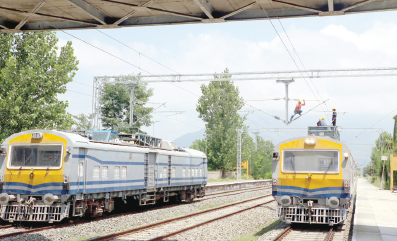Srinagar, July 27: Jammu and Kashmir’s railway infrastructure is witnessing a landmark transformation as Indian Railways launches a comprehensive modernisation drive across the valley, upgrading tracks and passenger coaches with cutting-edge technology.
Following the inauguration of the Udhampur-Srinagar-Baramulla Railway Link (USBRL) by Prime Minister Narendra Modi on June 6, 2025, mechanized track maintenance has replaced manual methods for the first time in the region. This shift promises enhanced safety, operational efficiency, and improved ride quality.
Chief Public Relations Officer HimanshuShekharUpadhyay told Rising Kashmir that scientific and machine-based maintenance practices have been introduced in Kashmir to boost speed, safety, and passenger comfort. Passenger coaches from the valley are now transported via the new rail link to overhaul facilities in Lucknow and Jalandhar, ensuring better performance and reliability. These upgrades are expected to be completed by the end of August.
The new maintenance regime employs Artificial Intelligence (AI) for real-time fault detection and predictive maintenance, reducing sudden failures and optimizing railway operations across the region.
The USBRL has fundamentally changed rail maintenance capabilities in Kashmir by enabling the movement of modern track maintenance machinery into the valley. Unlike earlier manual upkeep, the use of advanced machines is leading to significant improvements in track quality.
Officials confirmed that since early June 2025, a Tamping Machine has been deployed, compacting stone chips beneath the tracks to ensure proper alignment and stability. To date, it has tamped approximately 88 kilometers of track, enhancing the ballast cushion and smoothing rides for passengers.
In July 2025, two additional Ballast Cleaning Machines (BCMs) arrived in the valley, conducting deep screening on around 2.5 kilometers of track to further bolster track health. Supporting this work, 17 ballast rakes were transported and unloaded from Kathua, Qazigund, Madhopur, and Jind depots, resulting in nearly 19,000 cubic meters of fresh ballasting.
Quality assessments conducted via Track Recording Car (TRC) and Oscillation Monitoring System (OMS) runs in June and July identified track stretches needing targeted improvements, contributing to the overall enhancement of track infrastructure.
Across India, railway tracks are also undergoing rapid modernization. By early 2025, 78% of the network supports speeds of 110 kmph or more, up from just 39% in 2014. This growth accompanies an expansion of the network from 79,342 kilometers in 2014 to over 100,000 kilometers in 2025.
Earlier, Union Minister for Railways AshwiniVaishnaw highlighted Indian Railways’ commitment to scientific and efficient track maintenance. “We will improve track quality by significantly upgrading technology and maintenance practices. Modern track fittings, ultrasonic fracture detection machines, road-cum-rail vehicles, and integrated track measurement machines will make maintenance more scientific. AI will be extensively used to detect defects,” the minister stated.
He added that these advancements would also enhance working conditions for track maintenance personnel.The USBRL has fundamentally changed rail maintenance capabilities in Kashmir by enabling the movement of modern track maintenance machinery into the valley. Unlike earlier manual upkeep, the use of advanced machines is leading to significant improvements in track quality.
Officials confirmed that since early June 2025, a Tamping Machine has been deployed, compacting stone chips beneath the tracks to ensure proper alignment and stability. To date, it has tamped approximately 88 kilometers of track, enhancing the ballast cushion and smoothing rides for passengers.
In July 2025, two additional Ballast Cleaning Machines (BCMs) arrived in the valley, conducting deep screening on around 2.5 kilometers of track to further bolster track health. Supporting this work, 17 ballast rakes were transported and unloaded from Kathua, Qazigund, Madhopur, and Jind depots, resulting in nearly 19,000 cubic meters of fresh ballasting.
Quality assessments conducted via Track Recording Car (TRC) and Oscillation Monitoring System (OMS) runs in June and July identified track stretches needing targeted improvements, contributing to the overall enhancement of track infrastructure.
Across India, railway tracks are also undergoing rapid modernization. By early 2025, 78% of the network supports speeds of 110 kmph or more, up from just 39% in 2014. This growth accompanies an expansion of the network from 79,342 kilometers in 2014 to over 100,000 kilometers in 2025.
Earlier, Union Minister for Railways AshwiniVaishnaw highlighted Indian Railways’ commitment to scientific and efficient track maintenance. “We will improve track quality by significantly upgrading technology and maintenance practices. Modern track fittings, ultrasonic fracture detection machines, road-cum-rail vehicles, and integrated track measurement machines will make maintenance more scientific. AI will be extensively used to detect defects,” the minister stated.He added that these advancements would also enhance working conditions for track maintenance personnel.








